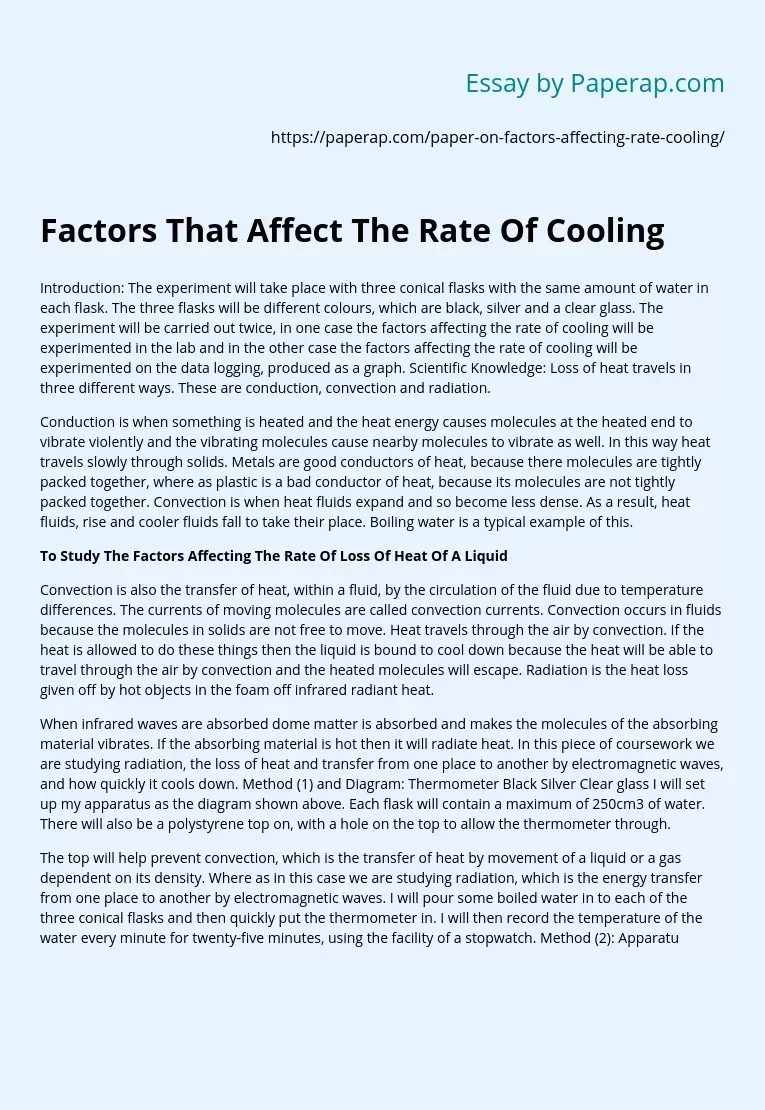Factors That Affect The Rate Of Cooling
Introduction: The experiment will take place with three conical flasks with the same amount of water in each flask. The three flasks will be different colours, which are black, silver and a clear glass. The experiment will be carried out twice, in one case the factors affecting the rate of cooling will be experimented in the lab and in the other case the factors affecting the rate of cooling will be experimented on the data logging, produced as a graph. Scientific Knowledge: Loss of heat travels in three different ways.
These are conduction, convection and radiation.
Conduction is when something is heated and the heat energy causes molecules at the heated end to vibrate violently and the vibrating molecules cause nearby molecules to vibrate as well. In this way heat travels slowly through solids. Metals are good conductors of heat, because there molecules are tightly packed together, where as plastic is a bad conductor of heat, because its molecules are not tightly packed together.
Convection is when heat fluids expand and so become less dense. As a result, heat fluids, rise and cooler fluids fall to take their place. Boiling water is a typical example of this.
To Study The Factors Affecting The Rate Of Loss Of Heat Of A Liquid
Convection is also the transfer of heat, within a fluid, by the circulation of the fluid due to temperature differences. The currents of moving molecules are called convection currents. Convection occurs in fluids because the molecules in solids are not free to move.
Heat travels through the air by convection. If the heat is allowed to do these things then the liquid is bound to cool down because the heat will be able to travel through the air by convection and the heated molecules will escape. Radiation is the heat loss given off by hot objects in the foam off infrared radiant heat.
When infrared waves are absorbed dome matter is absorbed and makes the molecules of the absorbing material vibrates. If the absorbing material is hot then it will radiate heat. In this piece of coursework we are studying radiation, the loss of heat and transfer from one place to another by electromagnetic waves, and how quickly it cools down. Method (1) and Diagram: Thermometer Black Silver Clear glass I will set up my apparatus as the diagram shown above. Each flask will contain a maximum of 250cm3 of water. There will also be a polystyrene top on, with a hole on the top to allow the thermometer through.
The top will help prevent convection, which is the transfer of heat by movement of a liquid or a gas dependent on its density. Where as in this case we are studying radiation, which is the energy transfer from one place to another by electromagnetic waves. I will pour some boiled water in to each of the three conical flasks and then quickly put the thermometer in. I will then record the temperature of the water every minute for twenty-five minutes, using the facility of a stopwatch. Method (2): Apparatus: Conical flask (black, silver and glass) x3 Thermometers x3 Polystyrene tops x3 Stopwatch x3 Kettle x3 Cotton wool x3.
Data logging facilities x3 Fair Test: Variables In order to make my test a fair test I will keep the same amount of water (volume) in each conical flask. Safety: Hypothesis (prediction): I predict that the black flask will emit the heat the most. I can prove this by the diagram below. Black Silver clear glass The arrows represent the directions of the heat being lost from each flask. As you can see the black flask does not absorb any heat at all and so emits all the heat energy out. In the silver flasks case the silver colour absorbs all the heat and so only a small amount of heat is lost from time to time.
The clear, glass flask reflects the heat and then loses a sufficient amount of heat. We can see from the above that the black flask will be the most likely to cool down the fastest. Results table: Temperature of how fast each flask cooled down (degrees Celsius). Time (min) Black Silver Clear glass 1.
Results (2): Data logging Results: Red: Black flask Blue: Clear, glass flask Green: Silver flask Conclusion: In this experiment I can conclude to say that the higher the rate of concentration the more the rate of reaction. This proves my theory of the collision theory. In order to complete this experiment more efficiently and effectively I could have had used better ffff Show preview only The above preview is unformatted text This student written piece of work is one of many that can be found in our GCSE Patterns of Behaviour section.
Factors That Affect The Rate Of Cooling. (2019, Dec 05). Retrieved from https://paperap.com/paper-on-factors-affecting-rate-cooling/

